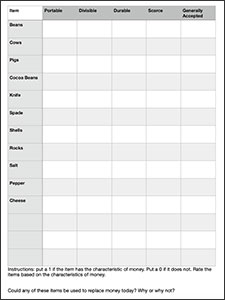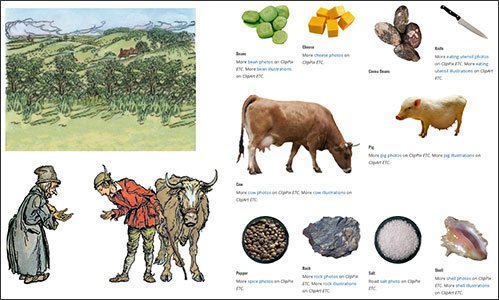
In this new series, Little Books Solve Big Problems, we will use classic children’s tales to introduce problems and have students come up with solutions. For example, in these activities, we are learning about trade and the characteristics of money, using the tale Jack and the Beanstalk.
(Find the free Jack and the Beanstalk audiobook and corresponding PDF on FCIT’s Lit2Go website.)
In Activity 1, students receive a email request from Jack III. The goal of the activity is to learn about currency of the past and understand the characteristics of money. Then in Activity 2, students demonstrate their understanding of the characteristics of money through the use of digital storytelling.
Message from Jack III:
From: Jack III
Re: Beans, Grandpa Jack, and Money
To: Students
Dear Students,
My name is Jack III and I am the grandson of the guy who grew that really tall beanstalk. When I read the story about my grandpa Jack, I thought it is really funny that he would trade his cow for beans! I learned in school that we use money to buy goods and services. When I told my teacher Ms. Bean, I thought Jack made a bad decision, she mentioned that we used to use all kinds of things as currency—that’s a fancy word for money. In fact, she said that both cows and beans were used as currency in the past!
Would you trade your favorite sneakers for some cheese? Imagine if you could walk into your favorite restaurant and pay with salt or pepper! In fact, my teacher told us that many things had been used as currency in the past, such as: cheese, salt, pepper, pigs, cows, rocks, shells, spades, knives, and cocoa beans.
Can you imagine using cows as currency? That is a question my teacher asked. We all LOL’d. Then she told us that in current times there are characteristics of money that are used to evaluate currency. Here they are:
- Divisible: Is it easy to divide?
- Durable: Is it strong and does it last?
- Portable: Can you carry it around?
- Generally Accepted: Is it accepted for purchasing goods and services?
- Scarce: Is it limited in supply?
Then my teacher gave us a fun activity. She gave us these images of things that have been used as currency in the past. We had to rank all of these alternatives based on the 5 characteristics of money.
Now it’s your turn. Below are links to the chart and the images. Rank all of the alternatives yourself. Then pick three other items you see around the classroom. Could any of these items replace the money we have today? Why or why not? Can you write me back with an answer?
Sincerely,
Jack III
62 Beanstalk Lane,
Harpville, USA

Money Chart PDF
Click to download PDF.

Gallery of Images for Activities 1 and 2
Click to open a collection of images in a new window. The gallery includes images for use with both activities one and two.
In this activity, students can illustrate their understanding of the characteristics of money through digital storytelling. For example, you can use:
• presentation software like PowerPoint or Keynote,
• digital storytelling apps, like Puppet Pals or Show Me.
Using the paper cut-out images of Jack and the man with whom he traded, create a scene where the man tries to trade one of the items we have used as currency in the past and have Jack explain why he won’t accept that item, based on the characteristics of money.
We hope you live happily ever until next time we post….
Dr. Deborah Kozdras has worked with students from K-20 and now provides professional development and creates curriculum for K-12 educators at the University of South Florida Stavros Center.
FCIT Newsletter
Each month FCIT publishes a newsletter with short articles on teaching and learning with technology, using digital content in the classroom, and technology integration. Subscribe today! The subscription form will open in a new window. When you have subscribed, you can close the new window to return to this page.
